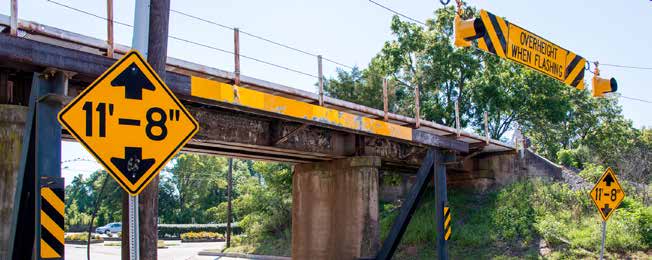Primer for Improved Urban Freight Mobility and Delivery
|
||
Key Accomplishments
|
A rail bridge passes just 11 feet 8 inches above South Gregson Street in downtown Durham, NC. Due to the low clearance under the bridge, South Gregson Street is not a truck route, and most professional truck drivers avoid the area. However, over time, numerous truck drivers have collided with the bridge. The bridge has even gained social media fame from online videos showing trucks and other types of vehicles striking it. To reduce the frequency of vehicle collisions with the bridge, the North Carolina Department of Transportation (NCDOT) installed a warning system that detects overheight vehicles and warns the drivers in real time that they cannot fit under the bridge and advises them to use an alternative route. The system also triggers a red light at the intersection immediately before the bridge to give drivers more time to observe the warning signal.
According to NCDOT, prior to installation of the warning system, there were an average of 1.4 bridge strikes per month. In most cases, the drivers who collide with the bridge are not professional truck drivers. Most professional truck drivers use truck-specific navigation systems, and they are aware of the vertical clearance needed to accommodate the vehicles they drive. Instead, many of the drivers who collide with the bridge are individuals who are driving rented vehicles such as moving trucks. Many of these drivers are unsure of the height of the vehicle they are driving, or they erroneously assume that the vehicle they are driving will be able to fit beneath the bridge.

A truck approaches the Gregson Street bridge in August 2017. Source: Jürgen Henn - 11foot8.com.
In the mid-2000s, NCDOT's Division 5 installed an overheight detection system before the Gregson Street bridge that used a laser to detect high objects (including trucks) approaching the bridge. The system then activated a flashing sign to warn the driver of the low-clearance bridge ahead. This system also included signage to direct drivers to a truck detour route. This system had flaws, however. Many of the drivers who collided with the bridge after this system was installed claimed that they did not see the signal or were not sure that the signal was directed toward them.

The Gregson Street Bridge with the previous overheight detection and warning system. Source: Washuotaku, Wikimedia Commons, licensed under the Creative Commons Attribution-Share Alike 4.0 International license.
In 2016, NCDOT installed a new system. When an overheight vehicle is detected, the new system triggers a newer, larger warning sign, which reads 'OVERHEIGHT, MUST TURN." The system also triggers the traffic light at the intersection immediately before the bridge to turn red and stop traffic. By stopping traffic at the intersection, the new system provides a better opportunity for the truck driver to observe the warning sign and decide to turn and avoid a collision. In addition, if the truck driver ignores the warning and proceeds when the light turns green, it is moving at a slower speed than if it had been passing through at the posted speed limit of 25 miles per hour, thus reducing the severity of crashes that occur.
The new system was funded with both State and Federal Highway Safety Improvement Program funds, which were awarded through a statewide competitive application process. The NCDOT's Division 5 office submitted the application, and NCDOT Headquarters selected the project for funding due to the frequency of collisions in this location. The project cost approximately $150,000 and included treatments to ensure context-sensitivity in the downtown environment. According to NCDOT, the cost of installing a similar system cost could be lower in an environment where such treatments are not necessary.
Since the project was completed in 2016, preliminary data collected by NCDOT indicates that collisions have declined significantly, from 1.4 per month to less than 0.4 per month.
Soon, NCDOT will perform a comprehensive review of the data to determine the long-term reductions in the number of collisions, crash severity, and costs. However, the project appears to have been successful in reducing the frequency and severity of crashes at this location. NCDOT division offices, as well as other State DOTs, have been in contact with NCDOT Division 5 to acquire additional information about this project.
John E. Sandor, P.E., NCDOT, 919-220-4600, jesandor@ncdot.gov
|
United States Department of Transportation - Federal Highway Administration |
||